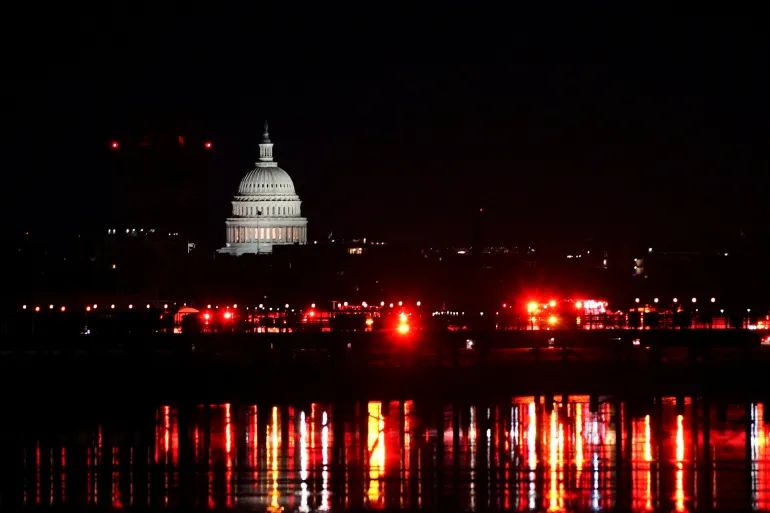In the wake of the tragic midair collision near Ronald Reagan Washington National Airport on January 29, speculation about the impact of President Donald Trump’s recent aviation policy changes has dominated social media. As emergency responders continue to recover the remains of those who perished in the crash, critics of Trump have raised concerns, pointing to his decisions as potential contributors to the tragic event. The collision involved a commercial jet flying from Wichita, Kansas, and a military Black Hawk helicopter, both of which collided in the skies near the nation’s capital. Some have questioned whether the timing of Trump’s policy changes, particularly the firing of key aviation officials and the suspension of hiring for air traffic controllers, could have had an immediate effect on aviation safety.
Several social media posts have claimed that Trump’s firings, including those of the heads of the Transportation Security Administration (TSA) and the U.S. Coast Guard, as well as the disbanding of the Aviation Security Advisory Committee, contributed directly to the accident. Critics allege that Trump’s actions—including the dismissal of aviation officials, freezing of hiring for air traffic controllers, and freezing the hiring of personnel in critical security positions—may have impacted air traffic safety just days before the crash. These claims, particularly from critics of the administration, have sparked a fierce debate across various platforms, where the question has been raised: Could the combination of these swift personnel changes and policy shifts have led to this fatal accident?
However, aviation experts and professionals have swiftly pushed back on these allegations, emphasizing that Trump’s actions were unlikely to have had an immediate effect on the crash. According to Jim Cardoso, a former U.S. Air Force colonel and a senior director at the University of South Florida’s Global and National Security Institute, the timing of Trump’s executive orders, especially considering the mere days between his inauguration and the accident, makes it highly improbable that they directly contributed to the crash. Cardoso explained that the procedures for controlling and deconflicting air traffic in the Washington, D.C. area have been in place for many years, long before the current administration took office, and thus, the personnel involved in the crash, including the air traffic controllers and the crews of the two aircraft, would not have been influenced by the recent policy changes.
The experts emphasize that, at the time of the accident, the individuals involved would have met the established qualifications and training requirements necessary for their positions, which would not have been affected by any recent policy changes related to diversity, equity, and inclusion (DEI) or executive orders aimed at reducing government staff. John Cox, a retired pilot and aviation safety consultant, echoed this sentiment, urging caution in making speculative claims so soon after such a tragic event. He stressed that it is crucial to wait for the official investigation to unfold and focus on the facts, rather than assigning blame based on political actions. “At this point, we don’t know enough,” Cox explained. “Speculation without facts is not helpful and only serves to cloud the investigation.”
Experts also pointed out that the investigations into aviation accidents typically take months to complete and often reveal factors that are not immediately apparent in the hours or days following the incident. The investigation into the D.C. crash is still in its early stages, and while it is understandable that people want to find answers quickly, jumping to conclusions without full knowledge of the facts does a disservice to the victims and to the ongoing process of determining the true cause.
The actions of President Trump, while controversial, are seen by some as part of a broader approach to government reform, which includes restructuring federal agencies and reducing what the administration views as burdensome regulations. On January 20, Trump issued a hiring freeze for federal civilian employees, which temporarily halted the creation of new positions and the filling of existing vacancies, though air traffic controllers were exempted due to their vital role in maintaining public safety. A day later, Trump signed an executive order that eliminated DEI hiring programs within the FAA, directing the transportation secretary to return to a merit-based system for hiring personnel in critical safety positions. The order also called for performance reviews for individuals in positions responsible for ensuring the safety of the aviation system.
While these executive actions have been controversial, experts argue that it is highly unlikely that they played a role in the crash, particularly given the brief time frame. Furthermore, reports have shown that staffing at the Reagan National Airport air traffic control tower was already strained prior to Trump’s policy changes, due in part to tight budgets, high employee turnover, and ongoing challenges related to staffing shortages across the country. The Federal Aviation Administration (FAA) has been facing a significant shortage of air traffic controllers, with a projected shortfall of 3,000 controllers by 2024. These staffing shortages, exacerbated by long shifts and fatigue, are seen by many as a more likely factor contributing to the accident.
A preliminary report by The New York Times on January 30 indicated that the air traffic control tower at Reagan National Airport was not fully staffed at the time of the crash. This has raised further concerns about the state of staffing at air traffic control facilities across the country, especially in the wake of Trump’s executive orders. However, it is still too early to say whether these staffing shortages played a direct role in the specific incident.
As the investigation continues, the focus must remain on the facts, experts say. The temptation to politicize such a tragic event should be avoided, as it could undermine the investigation’s integrity. “The idea is that it’s more important to get the right answer than to come up with a politically motivated explanation,” Cox noted.
For now, the aviation community and the public alike will have to wait for the results of a thorough investigation that will, in due time, reveal the causes of the crash. While the political landscape surrounding the incident may raise questions, it is the facts and evidence that will ultimately provide the answers. In the meantime, the focus must remain on the victims and their families, as well as on ensuring the continued safety of the aviation system in the future.
Stay ahead with the latest news on global innovation, leadership, entrepreneurship, business, and tech. Join us on WhatsApp or Telegram for real-time updates. Have a report or article? Send it to report@theinnovationtimes.com.
Follow us on X (Twitter), Instagram, LinkedIn, Pinterest, and Facebook for more insights and trends.



